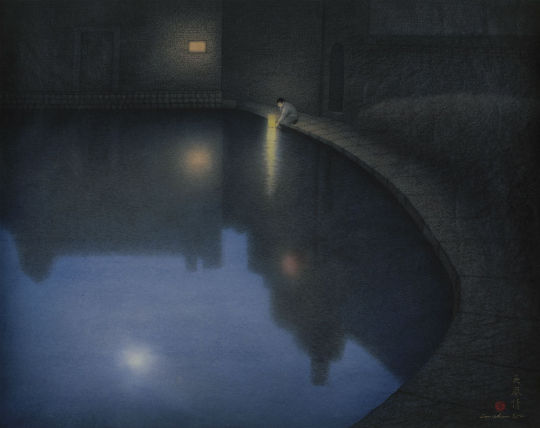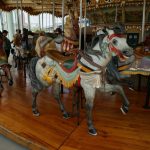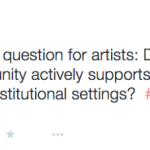Conversation: Wu Lan-Chiann’s World Through a Window
“I locate myself neither [in] contemporary American nor Chinese art, I see myself as contemporary ink painter.”
Wu Lan-Chiann is an ink painter and NYFA fiscally sponsored artist. Her delicate paintings are intimate yet powerful meditations that cross culture and time. Her upcoming solo exhibition at The Museum of East Asian Art in Bath, UK showcases her practice and artistic development over the past twenty years. Wu joins NYFA Current for an interview, sharing her ink paintings, inspiration and philosophy.
Exhibition: Reflections: Contemporary Ink Paintings by Wu Lan-Chiann
Dates: November 28, 2015 – May 15, 2016
Location: The Museum of East Asian Art, Bath, UK
Special Event: Meet the Artist: lecture and demonstration by Wu Lan-Chiann, Saturday, November 28, 2015, 2 PM to 3:30 PM
NYFA: Congratulations on your solo exhibition at the Museum of East Asian Art! Your ink paintings merge traditional Chinese painting with Western use of perspective and many combine elements from different times, spaces and cultural locations. In Lantern Festival I paper lanterns parade through rooftops in Florence, Italy. What role does travel play in your work? How do you distill experiences from around the world into concepts in your studio?
WLC: I explore universal values and themes that connect us as one people across time and place. This is really the core of my work; I paint what I feel not what I see. So, when I travel I become a keen observer of my real and imagined actual surroundings. As an old Chinese saying [states], ”It is better to travel 10,000 miles than to read 10,000 books.” Just like the ancient Chinese literati painters did, when I travel I make a visual diary in my mind and record my thoughts and experiences in one of my sketchbooks. Later on, when I reflect back, I develop some of these sketches into paintings, while others remain in my precious books.
A good example is Lantern Festival I (1999), which I made after visiting Florence in 1997. Fascinated by the architectural beauty of the city, I made several sketches looking down from one of the windows of the Palazzo Vecchio. To express my special feeling for the city, I wanted to give this painting a mesmerizing quality by creating a night scene. During the creation of this painting, my imagination brought me back to my favorite childhood festival in Taiwan. I realized no matter which city you visit (East or West), its energy is universal. This painting shows my interests in perspective and light, and illustrates that I make conscious connections between people and place across cultures.
NYFA: Do you connect your ability to draw upon different traditions to your role as an immigrant to the United States? How does your journey as an immigrant influence your art practice?
WLC: For as early as I can remember, I have viewed the world around me as if I was looking through the window. I think that I was, and perhaps still am, quite unique in the way that I observe daily life. I also discovered early on that through my artwork I could share with others my very personal vision of life.
I traveled through different countries and cultures and now I reside in the United States. The United States translated into Chinese means “Beautiful Country.” I have been attracted to the U.S. since childhood. I have never felt like an immigrant, but rather a global citizen. Today’s world is not the same anymore as how it was for our grandparents. The world has become a smaller place, which I think has shifted immigrant experience[s].
My environment often influences my work and people tell me they can see my paintings. They say that they feel transformed to a different place and feel calm; like meditation entering a mind state they wish to achieve in real life. Especially now, in our world of nanosecond communications, my paintings offer a moment of calm. My paintings are layered with content and meaning that each and all of us experience in life.
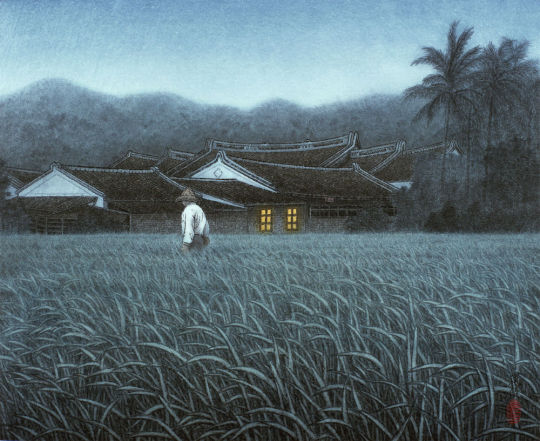
NYFA: In addition to thematically bridging place and time, the medium of ink painting also alludes to a different era. How do you navigate working with historical techniques in an age robust with technology? Where do you locate yourself within contemporary American and Chinese art?
WLC: Throughout my study in the fine arts, I worked with different paint media. However, I discovered that I have an umbilical connection with ink painting. Ink and paper give me the ability to create works that have a deeper meaning that goes beyond the image you see. To me it is similar to poetry, it has a deeper meaning beyond the beauty of the words.
In Chinese culture, ink painting goes back more than 3,000 years. Each imperial Dynasty produced important paintings made by some of the greatest masters in this media. While the dynasties have disappeared, ink painting continues as an important artistic practice and is increasingly appreciated by western audiences. Continuing the tradition of ink painting through exploration and innovation makes invaluable contribution[s] to preserving this art form.
That said, I have always been attracted to western painting styles, especially the use of perspective, light, and the representation of volume.
I see myself as a modern-day literati painter and, through my work, provide access to the depth, beauty, and rich tradition of Chinese ink painting. I locate myself neither [in] contemporary American nor Chinese art, I see myself as contemporary ink painter.
NYFA: What was your art education like as a child and how did you decide to pursue a career as an artist?
WLC: When I close my eyes, I can still see myself holding a pen or brush either drawing or painting. When I was about five years old I knew that I wanted to become an artist. I am fortunate to have had very good teachers, and my parents were very supportive. One day, I read in the daily Chinese children’s newspaper about a special art program at the National School that was funded by the Educational Department of the government in Taiwan. I asked my father to take me for a visit. I liked what I saw and became very determined to pursue art at that particular school despite its distance from my home. My resolve and stubbiness drove my parents crazy at that time.
When I was twelve, I won the second place in the national watercolor competition in Taiwan. I received an award from the Mayor of Taipei, and was offered a unique opportunity to enter the fine art program at the Taipei City Jinhua Girls’ Junior High School. That honor persuaded my parents to accept that I would walk twenty minutes to the train station, then take a one hour train and went on another half hour by bus to attend the school in Taipei each way, which meant four hours of public transportation to attend that particular art school. I was that determined!
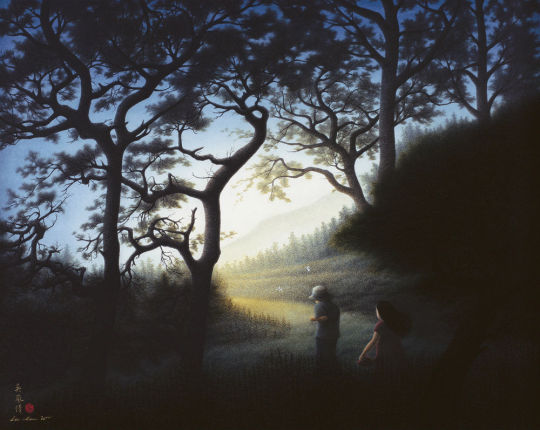
NYFA: What pedagogical differences did you encounter in your art education between studying art at Chinese Culture University in Taipei, Taiwan and New York University in New York City.
WLC: At the Chinese Culture University, I studied Chinese ink painting in a very traditional way, through copying masterpieces from the past. The idea behind this is that artists should learn from as many masters as they can, and not only learn through hard work and copying style, but also learn with the soul. From leading masters students learn how to create strong brushwork, apply color, and composition, and learn their wisdom to understand the spirit of creating art. At lot of what you learn, however, you have to absorb with your eyes, as the teachers often do not explain in great detail why and how they work in a certain way. As a student, you then take that knowledge and slowly become independent, so that eventually you make your own creative work. As part of my training, I copied numerous paintings in the collection of the National Palace Museum in Taipei, ranging from the Song dynasty through the late Qing dynasty. In addition, I learned from several masters, most notably from Au Ho-nien, a leading painter of the Lingnan school.
At NYU, quite naturally, I was exposed to more contemporary art and explored oil and acrylic painting. I studied with Professor Arnold Meshes, who was infectiously passionate about painting, and drove home the message that a love for painting is an utmost necessity for one’s pursuit in art making. His words found fertile ground with me.
Studying art in New York City rounded my artistic formation and gave me the opportunity to further explore blending Chinese and Western modes of representation. After my graduation, I circled back to ink painting, and I began to develop a more personal style, but adhered to traditional materials and techniques. Both Western art and Chinese art have unique qualities, which I equally value and embrace.

NYFA: What fuels your interest in the universal?
WLC: To me art is a universal language that people understand across time and place. I explore universal themes that form the base of our humanity. I have always been fascinated by the universal values and principles of life that is inherent to every society. We all ponder the question why are we here; what is our purpose and what is my/our destiny in this life? These are questions we all struggle with at some point in our life, and they have become recurring themes in my paintings.
In my dawn-to-dusk paintings, the recurring use of lights, sometimes only glimmers of light, are metaphors for human resilience, the hope, love, strength that each person carry within. Resilience is an innate strength we all share, which helps us during challenging phases in our lives.
NYFA: Why is finding personal connections within the universal valuable?
WLC: The renowned Six Dynasty Southern Song (375-443) landscape painter and philosopher, Zhong B’en said: “I am here surrounded by creation, my eyes see the things that surround me, that’s why I paint the shapes captured in my heart, that’s why I paint the colors I feel in my heart.”
For me, the essence of Chinese ink painting remains exactly as Zhong described it; not an actual representation or an imitation of nature, but rather nature represented through the soul and brush of the artist. I see it as the “mindscape” of the artist. I discovered early on that I could share with others my very personal vision on life. When I paint, I explore my feeling of what I have seen and sketched. It is a spiritual experience, and my painting becomes an extension of self; a reflection of my innermost world.
It is one of my professional goals to reach diverse audiences and show that, upon reflection, we are all one people. People that enter this world defenseless and curious, share the same hopes and fears, do the same simple acts of kindness, and go through the same stages of sorrow and grief. This is a main theme in my art, and I hope that my work will contribute to a broader dialogue about core benevolent values and principles that bind us together as one people. I want my paintings to provide a moment of contemplation for quiet reflection on the meaning of life. By using Eastern and Western modes of expression, painting techniques, aesthetics, and philosophy, I seek to transcend cultural boundaries and create a timeless commentary on humanity.
NYFA: Your project Life Cycle is fiscally sponsored by NYFA and it seems to resonate with individual funders. Can you please tell us a little about how fiscal sponsorship has helped you? Do you have any advice for other visual artists seeking funding for their own projects?
I am deeply grateful to the individual supporters who have provided funding for my project. Without them, I could not have reached this stage. I think that my personality might be one of the reasons that I have been successful in gaining individual support. By being true to myself, and by sharing my personal view on life through my art, I have made truly meaningful connections and lasting friendships.
Fiscal sponsorship is a very effective instrument for attracting support for art projects. At first, I was not aware of NYFA’s powerful concept, but now I understand much better. My next goal is to solicit corporate support, so that I can finalize Cycle of Life and bring it to fruition.
If I have any advice at all for fellow artists, I would say: be genuine and believe in your art, and then your art will work for you.
Curious to see more of Wu Lan-Chiann’s ink paintings? Click here to view her website and or visit this link to The Museum of East Asian Art. Wu is still fundraising for her fiscally sponsored project Cycle of Life and you can contribute a tax-deductible donation by clicking here. Is your next great project around the corner? Learn how NYFA Fiscal Sponsorship can help!
– Madeleine Cutrona, Fiscal Sponsorship Program Assistant
Images, from top: Lantern Festival I (1999), The Good Earth (2004), A Walk to Paradise Garden (2011), Precious Light (2012). Images courtesy of Wu Lan-Chiann, photographs by Ton Wilmering

